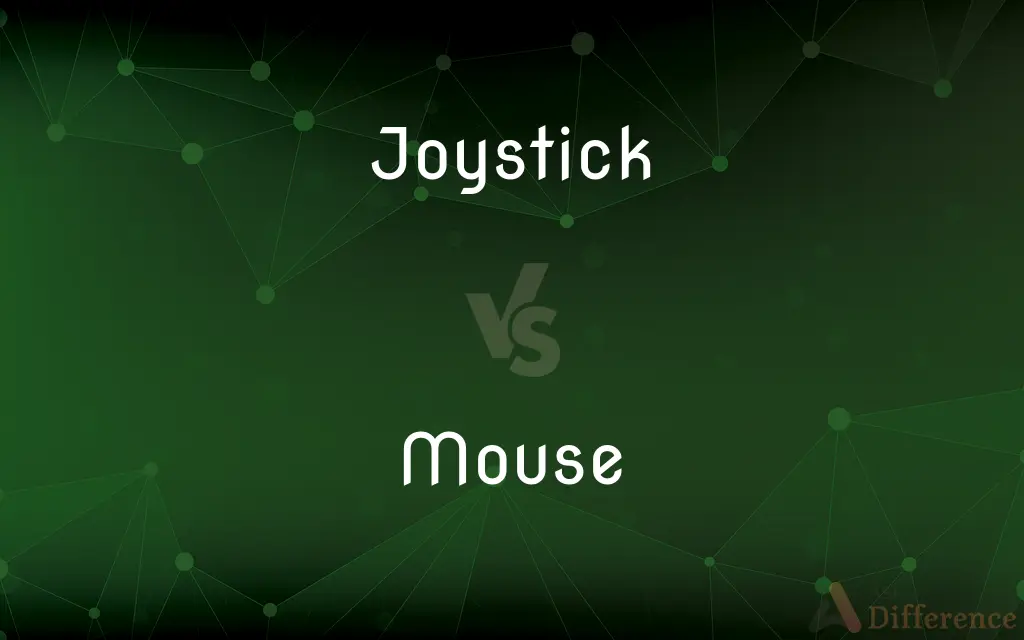Joystick vs. Mouse — What's the Difference?
Edited by Tayyaba Rehman — By Urooj Arif — Updated on March 21, 2024
A joystick allows for directional control in a physical, tangible form, while a mouse translates surface movements into on-screen cursor movements.

Difference Between Joystick and Mouse
Table of Contents
ADVERTISEMENT
Key Differences
A joystick is a controller that provides interactive input by translating physical movement into digital output, often used for gaming or controlling machines. On the other hand, a mouse is a peripheral that detects two-dimensional motion relative to a surface, primarily used for navigating graphical user interfaces.
Joysticks are characterized by their stick-based design, allowing for nuanced control in multiple directions, which is particularly beneficial in flight simulators or driving games. In contrast, mice offer precise point-and-click functionality, making them ideal for tasks that require fine cursor movements, such as graphic design or text editing.
While joysticks can offer a more immersive experience for certain types of games or simulations, they generally lack the versatility and widespread application of mice in everyday computing tasks. Conversely, mice are not as effective in applications that require continuous directional input or where tactile feedback is beneficial.
Joysticks may come with additional features such as buttons and triggers for added functionality, tailored to specific game genres or control systems. Mice, however, have evolved to include features such as scroll wheels and customizable buttons to enhance productivity and user experience in a wide range of applications.
Comparison Chart
Primary Use
Gaming, simulations, machine control.
Navigating graphical user interfaces.
ADVERTISEMENT
Design
Stick-based, allows for directional control.
Flat, designed to detect surface movements.
Input Method
Physical movement in multiple directions.
Two-dimensional motion detection.
Common Features
Buttons, triggers, tactile feedback.
Scroll wheel, customizable buttons.
Application
Specific games/simulations, less versatile.
Versatile, used in a wide range of tasks.
Compare with Definitions
Joystick
A device that can be moved in all directions to control the movement of an image on a computer or similar display screen.
Use the joystick to navigate the spaceship through the asteroid field.
Mouse
A small handheld device that is dragged across a flat surface to move the cursor on a computer screen.
Move the mouse to click on the icon.
Joystick
A control stick that directs the path of a vehicle, especially an aircraft.
The flight simulator's joystick mimicked the feel of a real cockpit.
Mouse
A device that controls the movement of the cursor or pointer on a display screen.
The wireless mouse made it easier to work from anywhere in the room.
Joystick
A lever used to control the movement or direction of something mechanical.
The crane operator used the joystick to lift the heavy beams.
Mouse
A pointing device that detects two-dimensional motion.
Customize the mouse buttons to streamline your workflow.
Joystick
A lever that can be moved in several directions to control the movement of an image on a computer screen.
The arcade game's joystick felt responsive and precise.
Mouse
A peripheral device used to point to items on a screen.
The designer used her mouse to navigate the graphic editing software.
Joystick
A device used to control video games or other machines.
The pilot adjusted the joystick to stabilize the drone.
Mouse
A computer input device that uses a rolling ball or optical sensor to detect motion.
The optical mouse provided smooth cursor movement on different surfaces.
Joystick
A joystick is an input device consisting of a stick that pivots on a base and reports its angle or direction to the device it is controlling. A joystick, also known as the control column, is the principal control device in the cockpit of many civilian and military aircraft, either as a centre stick or side-stick.
Mouse
A mouse, plural mice, is a small rodent. Characteristically, mice are known to have a pointed snout, small rounded ears, a body-length scaly tail, and a high breeding rate.
Joystick
The control stick of an aircraft.
Mouse
A lump or bruise on or near the eye
She touched the mouse under her eye
Joystick
A manual control or cursor device, as one attached to a computer or video game.
Mouse
A small rodent that typically has a pointed snout, relatively large ears and eyes, and a long tail.
Joystick
A mechanical device consisting of a handgrip mounted on a base or pedestal and typically having one or more buttons, used to control an aircraft, computer, or other equipment.
Mouse
A small handheld device which is moved across a mat or flat surface to move the cursor on a computer screen
The right mouse button
Copy the file with a click of the mouse
Joystick
(slang) A penis.
Mouse
(of a cat or owl) hunt for or catch mice
Female cats are usually much better at mousing than males
Joystick
(rare) To manoeuvre by means of a joystick.
Mouse
Use a mouse to move or position a cursor on a computer screen
Simply mouse over any item on the list
Joystick
A lever used by a pilot to control the ailerons and elevators of an airplane
Mouse
Any of numerous small rodents of the families Muridae and Cricetidae, such as the house mouse, characteristically having a pointed snout, small rounded ears, and a long naked or almost hairless tail.
Joystick
A manual control consisting of a vertical handle that can move freely in two directions; used as an input device to computers or to devices controlled by computers
Mouse
Any of various similar or related animals, such as the jumping mouse, the vole, or the jerboa.
Mouse
A cowardly or timid person.
Mouse
(Informal) A discolored swelling under the eye caused by a blow; a black eye.
Mouse
Pl. mice or mous·es (mousĭz) Computers A handheld, button-activated input device that when rolled along a flat surface directs an indicator to move correspondingly about a computer screen, allowing the operator to move the indicator freely, as to select operations or manipulate text or graphics.
Mouse
To hunt mice.
Mouse
To search furtively for something; prowl.
Mouse
Any small rodent of the genus Mus.
Mouse
(informal) A member of the many small rodent and marsupial species resembling such a rodent.
Mouse
A quiet or shy person.
Mouse
(computing) (plural mice or, rarely, mouses) An input device that is moved over a pad or other flat surface to produce a corresponding movement of a pointer on a graphical display.
Mouse
(computing) The cursor.
Mouse
(boxing) A facial hematoma or black eye.
Mouse
(nautical) A turn or lashing of spun yarn or small stuff, or a metallic clasp or fastening, uniting the point and shank of a hook to prevent its unhooking or straightening out.
Mouse
(obsolete) A familiar term of endearment.
Mouse
A match used in firing guns or blasting.
Mouse
(set theory) A small model of (a fragment of) Zermelo-Fraenkel set theory with desirable properties (depending on the context).
Mouse
(historical) A small cushion for a woman's hair.
Mouse
Part of a hind leg of beef, next to the round.
Mouse
(intransitive) To move cautiously or furtively, in the manner of a mouse (the rodent) (frequently used in the phrasal verb to mouse around).
Mouse
(intransitive) To hunt or catch mice (the rodents), usually of cats. 12
Mouse
To close the mouth of a hook by a careful binding of marline or wire.
Mouse
To navigate by means of a computer mouse.
Mouse
To tear, as a cat devours a mouse.
Mouse
Any one of numerous species of small rodents belonging to the genus Mus and various related genera of the family Muridæ. The common house mouse (Mus musculus) is found in nearly all countries. The American white-footed mouse, or deer mouse (Peromyscus leucopus, formerly Hesperomys leucopus) sometimes lives in houses. See Dormouse, Meadow mouse, under Meadow, and Harvest mouse, under Harvest.
Mouse
A knob made on a rope with spun yarn or parceling to prevent a running eye from slipping.
Mouse
A familiar term of endearment.
Mouse
A dark-colored swelling caused by a blow.
Mouse
A match used in firing guns or blasting.
Mouse
To watch for and catch mice.
Mouse
To watch for or pursue anything in a sly manner; to pry about, on the lookout for something.
Mouse
To tear, as a cat devours a mouse.
Mouse
Any of numerous small rodents typically resembling diminutive rats having pointed snouts and small ears on elongated bodies with slender usually hairless tails
Mouse
A hand-operated electronic device that controls the coordinates of a cursor on your computer screen as you move it around on a pad; on the bottom of the mouse is a ball that rolls on the surface of the pad;
A mouse takes much more room than a trackball
Mouse
To go stealthily or furtively;
..stead of sneaking around spying on the neighbor's house
Mouse
Manipulate the mouse of a computer
Common Curiosities
How does a mouse detect movement?
A mouse detects movement through a rolling ball or optical sensor that tracks its motion relative to the surface it's on.
Can a mouse be used for gaming?
Yes, mice are widely used in gaming, especially in genres that require precise point-and-click actions, such as strategy or first-person shooters.
Can a joystick replace a mouse for everyday computing?
Due to their design and functionality, joysticks are not typically practical for standard computing tasks that require precise cursor control.
Can a mouse be used for flight simulators?
While possible, a mouse may not provide the immersive and nuanced control that a joystick can offer in flight simulations.
Is it possible to use a mouse and joystick simultaneously?
Yes, many gamers and professionals use both devices simultaneously to leverage the unique advantages of each in their respective applications.
What is the primary function of a joystick?
The joystick is primarily used for directional control in gaming, simulations, and machine operation, offering nuanced input.
Do professional gamers use joysticks?
Professional gamers might use joysticks for specific game genres where they provide a competitive advantage or enhance the gaming experience.
Are joysticks still relevant in modern computing?
While less common in everyday computing, joysticks remain relevant in specific applications like flight simulators, driving games, and certain industrial controls.
Are wireless joysticks and mice widely available?
Yes, wireless versions of both devices are available, providing more flexibility and reducing clutter from cords.
How do I choose between a joystick and a mouse?
Your choice should be based on the primary tasks you intend to perform; a mouse for general computing and precision tasks, and a joystick for gaming or simulation.
How do maintenance and durability compare between a joystick and mouse?
Mice generally have fewer moving parts and may require less maintenance, whereas joysticks might need more attention due to their complex mechanisms.
Are there any devices that combine features of both a mouse and joystick?
Hybrid devices exist, offering the precision of a mouse with the directional control of a joystick for specialized applications.
Do joysticks and mice require specific software to function?
While basic functions don't require special software, advanced features and customization may require dedicated software or drivers.
Can the sensitivity of a joystick and mouse be adjusted?
Yes, both devices typically allow for sensitivity adjustments to suit user preferences and application requirements.
Share Your Discovery

Previous Comparison
Arcane vs. Arcanum
Next Comparison
Rider vs. RyderAuthor Spotlight
Written by
Urooj ArifUrooj is a skilled content writer at Ask Difference, known for her exceptional ability to simplify complex topics into engaging and informative content. With a passion for research and a flair for clear, concise writing, she consistently delivers articles that resonate with our diverse audience.
Edited by
Tayyaba RehmanTayyaba Rehman is a distinguished writer, currently serving as a primary contributor to askdifference.com. As a researcher in semantics and etymology, Tayyaba's passion for the complexity of languages and their distinctions has found a perfect home on the platform. Tayyaba delves into the intricacies of language, distinguishing between commonly confused words and phrases, thereby providing clarity for readers worldwide.














































